Samsung has launched the 990 EVO, the latest entry-level drive from the company’s popular line of client SSDs. Positioned as an upgrade to the 970 EVO Plus, the Samsung 990 EVO aims to balance performance, energy efficiency, and broad interface compatibility, catering to the diverse needs of today’s consumers.
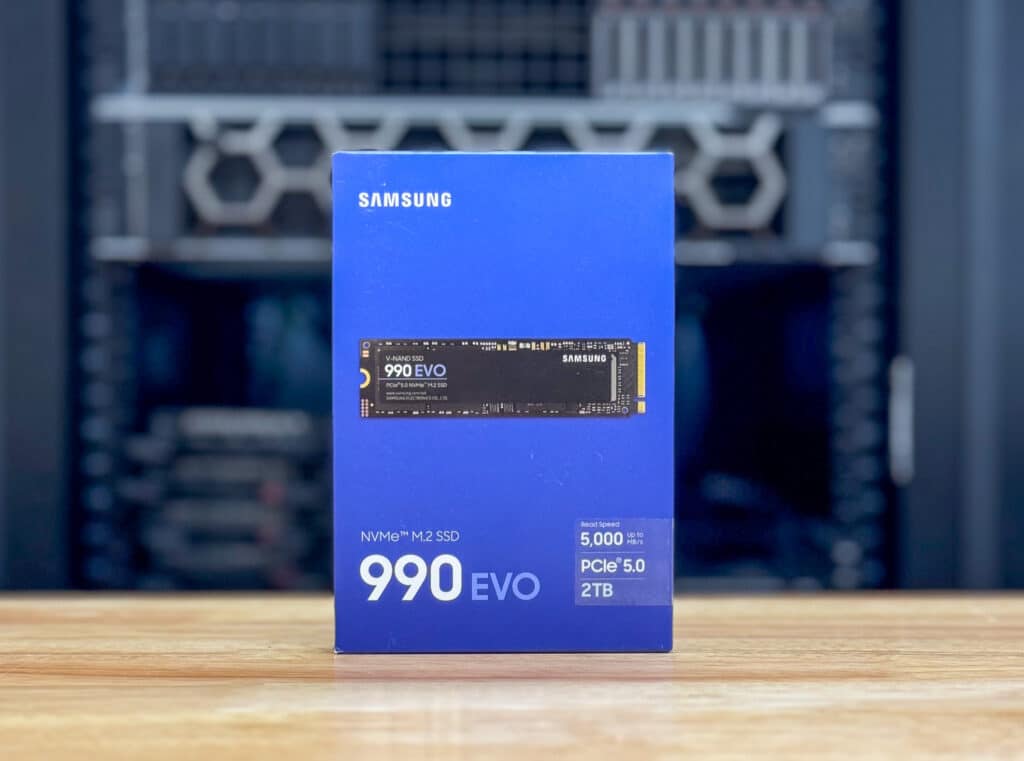
Samsung 990 EVO Performance Profile
While Samsung claims the 990 EVO is a significant improvement over its predecessor, boasting up to 43 percent faster performance, it has some significant caveats. The SSD’s designation as a Gen5 drive piqued our interest the most. While it technically falls into this category, it’s important to note that it operates on two lanes of Gen5 and four lanes of Gen4. While it is compatible with Gen4 and Gen5 systems, it doesn’t fully leverage the 14GB/s speed often associated with Gen5.
As such, Samsung indicates a modest performance profile, with sequential read and write speeds up to 5,000 MB/s and 4,200 MB/s respectively. The random read and write performance is quoted at up to 680,000 IOPS and 800,000 IOPS, respectively, for the 1 TB model (and slightly better for the 2 TB variant), providing a decent level of responsiveness.
While these numbers are satisfactory for general use, like word processing, media consumption, and some gaming, they do not match the higher performance metrics of more premium models in the market. There’s no problem with that, so long as pricing is in line with performance. This leads us to…
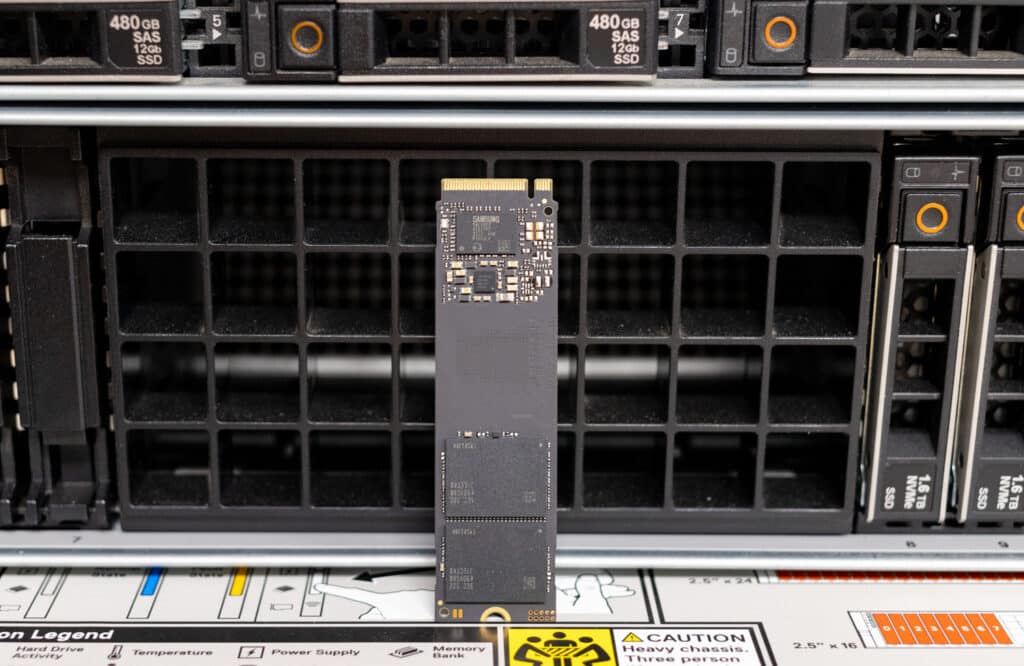
Samsung 990 EVO Pricing
The Samsung 990 EVO is slated for release in 1 TB and 2 TB capacities, with the 1 TB model priced at $124.99 and the 2 TB at $209.99. However, given that these prices are notably higher than those of high-performance SSDs, including the significantly more advanced Samsung 990 Pro, we advise potential buyers to consider waiting for a massive price correction before looking seriously at the 990 EVO. The current pricing places the 990 EVO in a challenging position in the market, particularly when compared with superior models available at similar or lower price points—more on this in the performance and conclusion sections.
Samsung 990 EVO Power Efficiency and Features
The 990 EVO introduces enhanced power efficiency, reportedly up to 70 percent better than the 970 EVO Plus. This is a significant consideration for laptop users concerned about battery life. The SSD includes a heat spreader label for effective thermal management and support for Microsoft Modern Standby.
The 990 EVO also boasts the usual features from Samsung’s client SSDs: TRIM Support for optimized data management and longevity, SMART Support for monitoring SSD health, efficient space management through GC (Garbage Collection), and an Auto Garbage Collection Algorithm. Data security is ensured with AES 256-bit encryption, meeting TCG/Opal IEEE1667 standards, while its device’s sleep mode aids in reducing power consumption and enhancing energy efficiency.
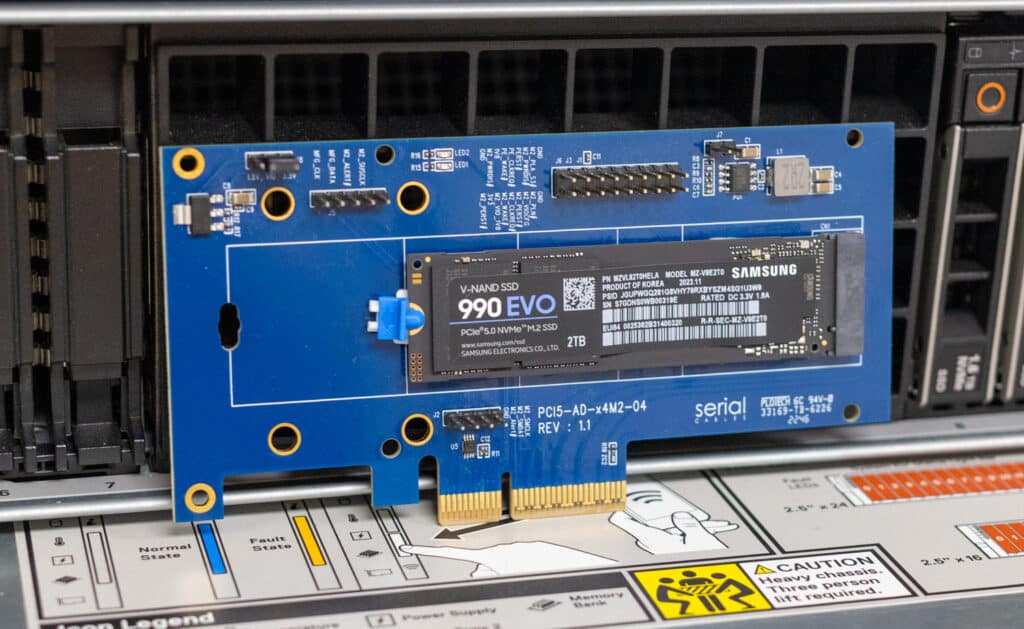
It also supports the Samsung Magician Software, a fantastic free SSD management tool regarded as the market leader. This software enhances the overall user experience by providing comprehensive tools for monitoring, optimizing, and securing the SSD while featuring responsive, modern, and user-friendly navigation. Read our Samsung Magician 8 review for a detailed look at the most recent version.
Samsung 990 EVO SSD Specifications
Specification |
Detail |
| Model | Samsung 990 EVO |
| Capacities | 1 TB, 2 TB |
| Interface | PCIe 4.0 x4 / 5.0 x2 NVMe 2.0 |
| Form Factor | M.2 (2280) |
| NAND Type | Samsung V-NAND TLC |
| Controller | Samsung in-house Controller |
| Cache | HMB (Host Memory Buffer) |
| Performance |
|
| Average Power Consumption (System Level) |
|
| Power Consumption (Idle) | 1 TB & 2 TB: Typical 60 mW |
| Power Consumption (Device Sleep) | 1 TB & 2 TB: Typical 5 mW |
| Allowable Voltage | 3.3 V ± 5 % Allowable voltage |
| Reliability (MTBF) | 1.5 Million Hours Reliability (MTBF) |
| Operating Temperature | 0 – 70 ℃ Operating Temperature |
| Shock | 1,500 G & 0.5 ms (Half sine) |
| Features |
|
| Power Efficiency | Up to 70 percent better than 970 EVO Plus |
| Warranty | 5-Year Limited Warranty |
| Additional Features | Heat Spreader Label, Samsung Magician Software |
Samsung 990 EVO SSD Performance
For this review, we will be looking at the 2 TB model while comparing it to the following SSDs:
For testing, we use two platforms. The consumer test platform supports PCIe Gen4/Gen5 SSDs. It is sometimes leveraged for lighter consumer-based tests such as BlackMagic DiskSpeed Test, CrystalDiskMark, and our main platform, a Dell PowerEdge R760, which overlaps our enterprise tests. Serial Cables supplied an 8-bay PCIe Gen5 JBOF for U.2/U.3, M.2, and E1.S/E3.S drive testing. This allows us to test all current and emerging drive types on the same test hardware.
Dell PowerEdge R760 Configuration
- Dual Intel Xeon Gold 6430 (32 cores/64 threads, 1.9GHz base)
- 1TB DDR5 RAM
- Ubuntu 22.04
VDBench Workload Analysis
When benchmarking storage devices, application testing is best, and synthetic testing is second. While not a perfect representation of actual workloads, synthetic tests help baseline storage devices with a repeatability factor that makes it easy to compare competing solutions. These workloads offer a range of testing profiles ranging from “four corners” tests and common database transfer size tests to trace captures from different VDI environments.
These tests leverage the common vdBench workload generator, with a scripting engine to automate and capture results over a large compute testing cluster. This allows us to repeat the same workloads across various storage devices, including flash arrays and individual storage devices. Our testing process for these benchmarks fills the entire drive surface with data, then partitions a drive section equal to one percent of the drive capacity to simulate how the drive might respond to application workloads. This differs from full entropy tests, which use 100 percent of the drive and take them to a steady state. As a result, these figures will reflect higher-sustained write speeds.
Profiles:
- 4K Random Read: 100% Read, 128 threads, 0-120% iorate
- 4K Random Write: 100% Write, 64 threads, 0-120% iorate
- 64K Sequential Read: 100% Read, 16 threads, 0-120% iorate
- 64K Sequential Write: 100% Write, 8 threads, 0-120% iorate
- VDI Profiles
Starting with 4K random read, the Samsung 990 EVO SSD drive performed poorly, hitting just over 130 thousand IOPS at 980.1ms. The 990 Pro and T500 were far superior drives here, with the former almost reaching a million IOPS.
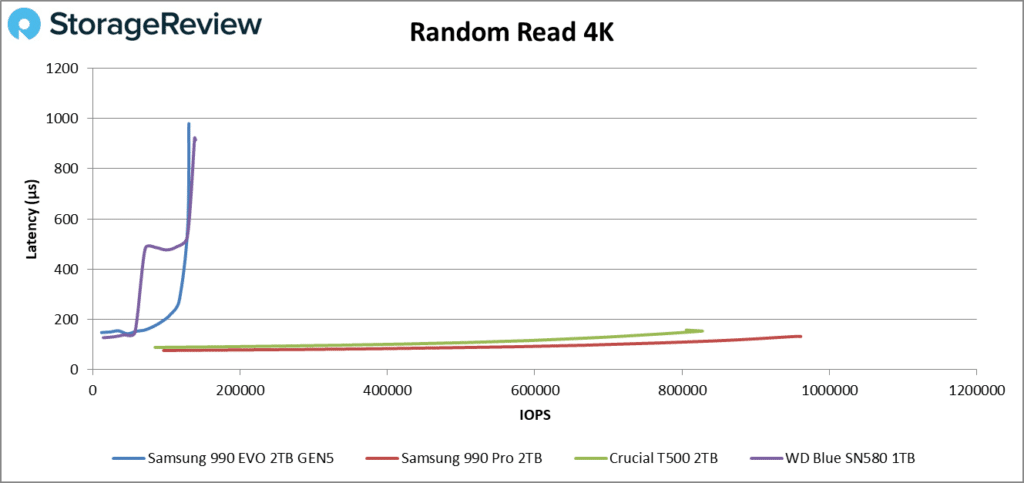
4K random writes told a similar story, with the new 990 EVO peaking at 34K IOPS at 3,783ms in latency. Again, the best-performing drive here was the less expensive Samsung 990 Pro.
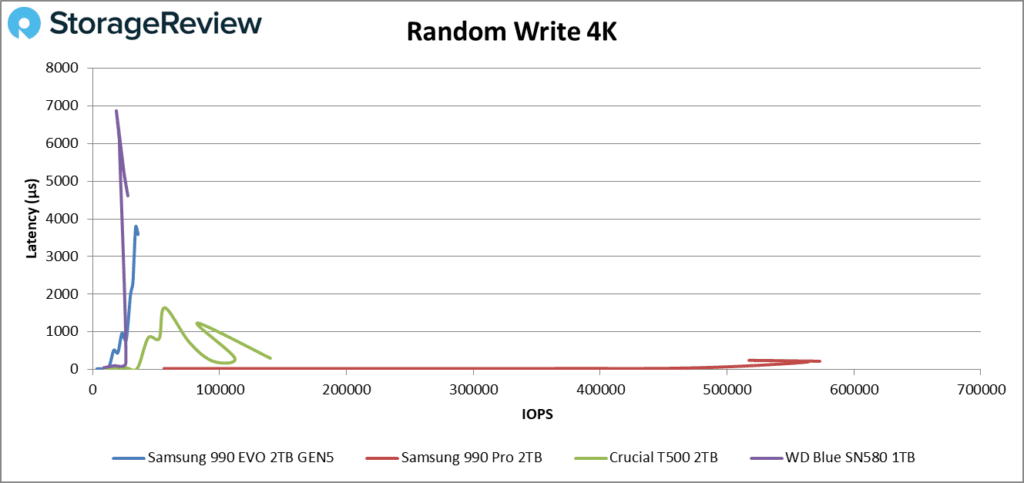
When switching to the sequential read 64K workload, the 990 EVO took a severe hit in latency, starting at the 25K IOPS mark and eventually hitting 1,131ms at 30K IOPS. The test ended at just 3.22GB/s read at a latency of 548.4ms for last place. Again, the older and less expensive 990 Pro was by far the best drive here.
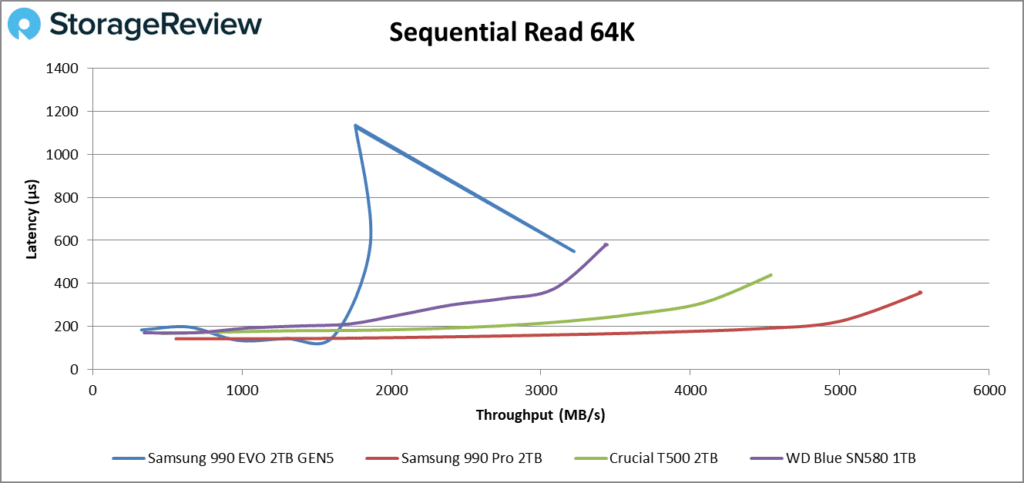
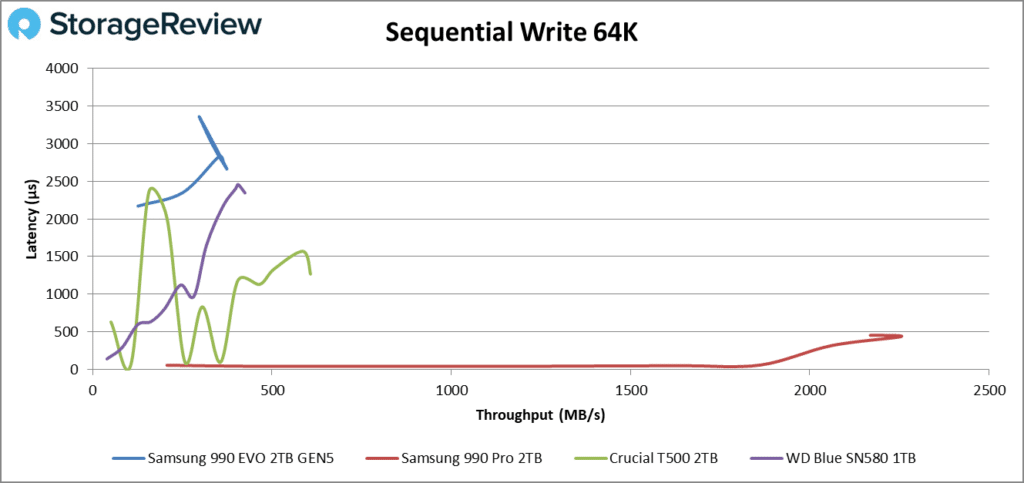
Next, we looked at our VDI benchmarks, designed to tax the drives further. These tests include Boot, Initial Login, and Monday Login. Starting with boot, the Samsung 990 EVO latency increased quickly, ending the test around the 33K IOPS mark at 1,050ms.
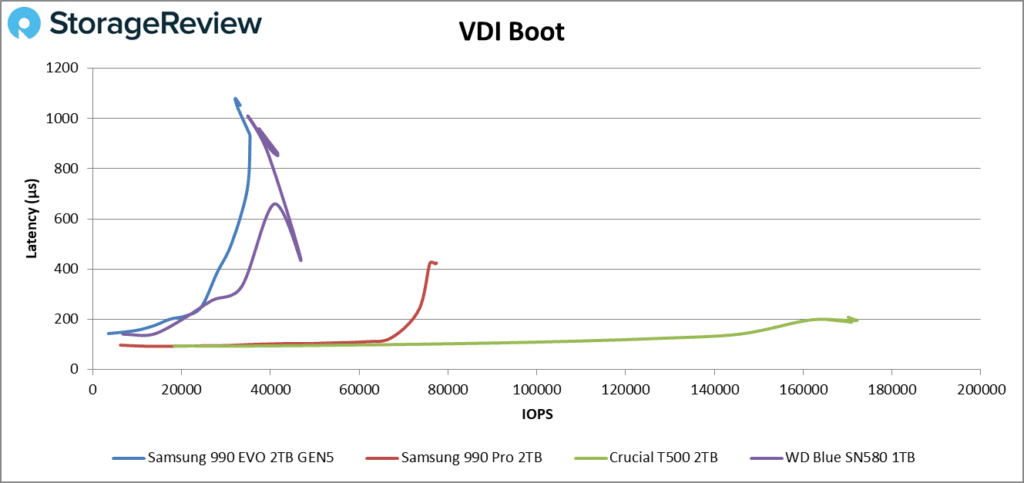
Next up is VDI Initial Login. Here, the Samsung 990 EVO demonstrated high latency numbers again and, by the end of the test, hit 2,855.1ms and just 10K IOPS.
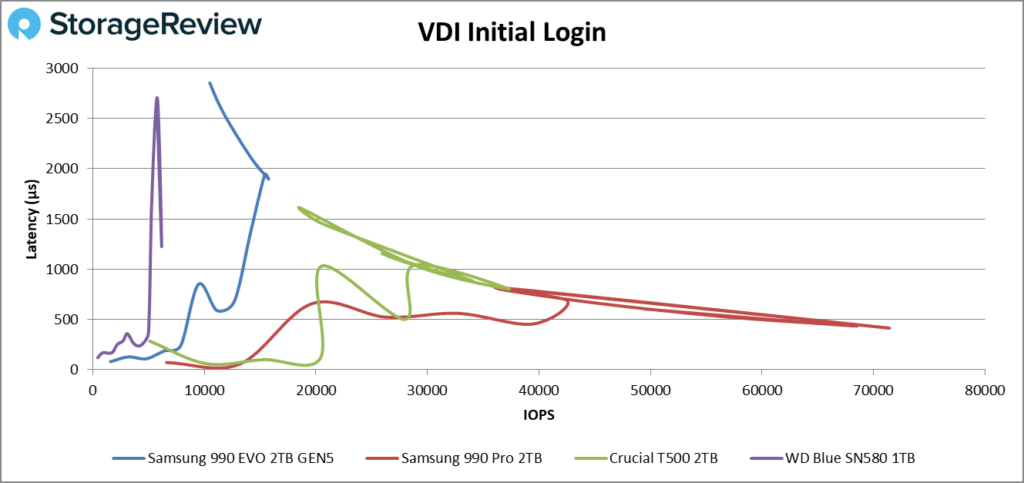
Finally, we have the VDI Monday Login benchmark, concluding the test at just 11K IOPS with a latency of 1,450ms.
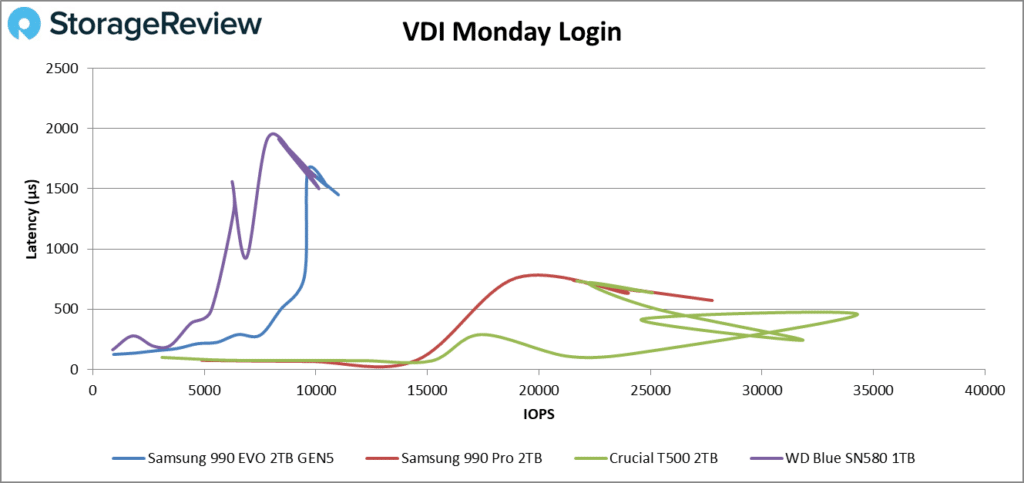
BootBench
BOOT-BENCH-1 is a workload profile adopted by OCP to profile SSDs designed for server boot duty. While this is intuitively a job for enterprise SSDs, client SSDs are often selected for their performance, capacity, and cost combination. The boot drive issue is germane to hyperscalers and server and storage system providers, as they face similar challenges.
This boot workload executes an intense test plan that fills the entire drive with writes before testing a read-heavy workload sequence. For each test, it performs a 32K random read async operation alongside a 15MiB/s synchronous 128k random write and a 5MiB/s synchronous 128k random write/trim background workload. The script starts with the random-read activity at a 4-job level and scales up to 256 jobs at its peak. The final result is the read-operations performed during its peak run.
The OCP goal for this benchmark is a pass/fail at 60K read IOPS. Most drives we test will far exceed the minimum, but the results are instructive regardless.
The Samsung 990 EVO, unsurprisingly, wasn’t able to complete the test and so received a “DNF” on the current boot leaderboard:
| SSD | Read IOPS |
| Sk hynix Platinum P41 | 220,884 IOPS |
| WD SN850X | 219,883 IOPS |
| Solidigm P44 Pro | 211,999 IOPS |
| Fantom VENOM8 | 190,573 IOPS |
| Samsung 990 Pro | 176,677 IOPS |
| Sabrent Rocket 4 Plus | 162,230 IOPS |
| ADATA Legend 970 (Gen5) | 65,632 IOPS |
| Corsair MP700 Pro (Gen5) | 51,521 IOPS |
| Predator Storage GM7 | 35,302 IOPS |
| Samsung 990 EVO | DNF |
Samsung 990 EVO CrystalDiskMark Speed Test
We performed a lighter-weight test on the Samsung 990 EVO to demonstrate another metric of its speeds. CrystalDiskMark’s higher queue depth (compared to BlackMagic) allows us to showcase the best-case scenario for the drive. Any real-world performance differences would likely be negligible.
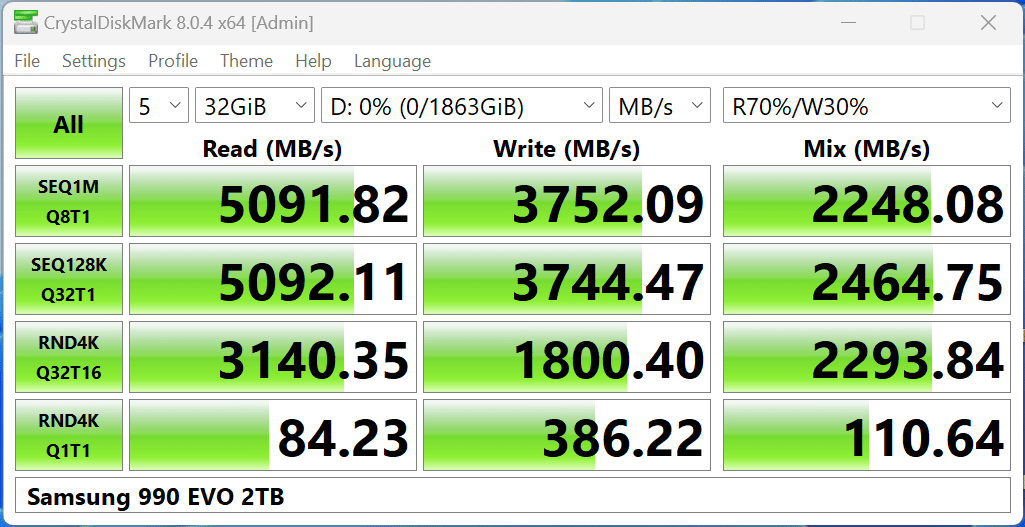
Samsung 990 EVO BlackMagic DiskSpeed Test
Lastly, we measured performance inside a Windows 11 environment on our consumer test platform via the popular Blackmagic test. The new Samsung 990 EVO hit just 4.26GB/s read and 3.44GB/s write.
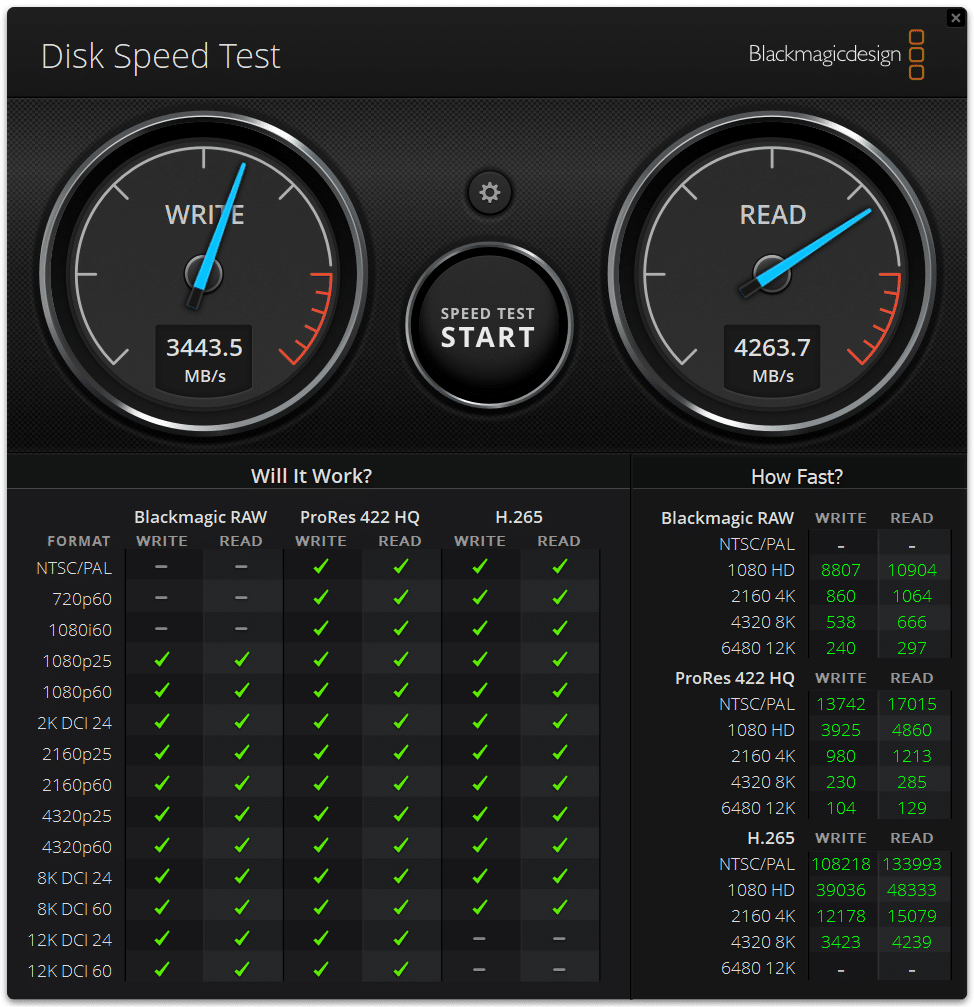
Conclusion
Samsung’s 990 EVO emerges as the latest mainstream SSD offering from Samsung, positioned as an upgrade to the 970 EVO Plus. This drive is designed to balance performance with energy efficiency and interface compatibility. With the usual features like TRIM and SMART support, it aims to offer consumers a viable (albeit basic) SSD experience. However, it falls well short of advancing beyond its predecessor’s capabilities. Moreover, the SSD’s Gen5 classification is also somewhat ambiguous, as it operates on a limited 2 lanes of Gen5 and 4 lanes of Gen4, not fully utilizing the expected speed of Gen5 technology.
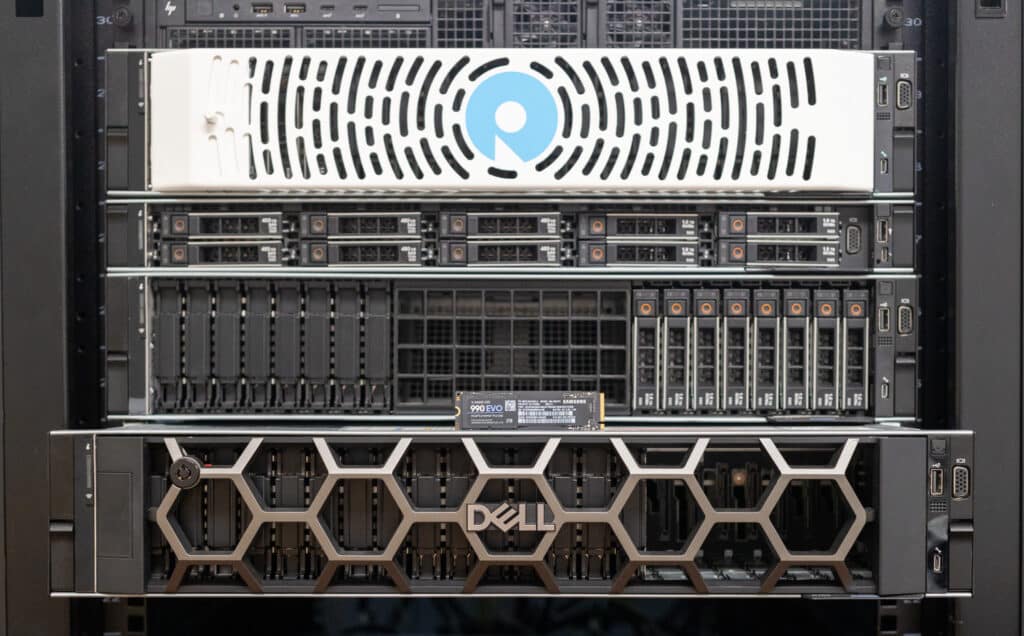
The performance results of the 990 EVO were lackluster as well, especially in today’s competitive SSD market. Our testing showed feeble performance across various benchmarks, including 4K random read/write and sequential workloads, with the drive exhibiting very high latency and low IOPS compared to alternatives like the Crucial T500 and especially the Samsung 990 Pro. These results are certainly disappointing, especially considering its positioning.
The biggest issue with the 990 EVO SSD is its pricing strategy. Samsung made a bewildering decision here. At $209 for the 2TB model, it shockingly sits much more expensive than its advanced sibling, the Samsung 990 Pro (priced at just $180), and even higher compared to the speedy WD SN850x, which is available for a mere $144. Coupled with its lackluster performance, the 990 EVO’s inflated pricing makes it an economically irrational choice, especially in a segment where consumers seek the best bang for their buck.
Given the excessive pricing of the Samsung 990 EVO at launch and the dismal performance profile, we can’t recommend this drive at all. The 990 Pro is the only Samsung drive worth considering. Maybe one day the math will change and the 990 EVO will be an affordable option, but even then, there are likely to be better options.




 Amazon
Amazon